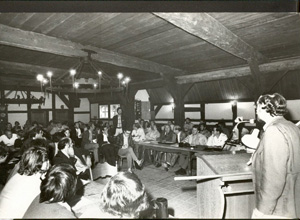|
Preface
|
| |
Rolf
Neth Hämatol. Bulttransf. Vol 14 |
|
Nearly every month there are workshops, conferences
or congresses devoted to the problems of human leukemia, for our knowledge
is quite limited. In large measure, these conferences have been concerned
with special aspects of leukemia. In this workshop we have brought together
scientists from different research areas in human leukemia. Therefore the
title "Modern Trends in Human Leukemia" does not only apply to the discussion
of the importance of molecular biology, but also includes the 100 year old
history of the leukemic cell as the basis of biological and immunological
aspects in human leukemia. Modern trends in human leukemia need to be discussed
based on the past, present and possible future information gathered from
all different, but related topics. The idea to bring together highly qualified
biochemists, medical doctors, and virologists to learn, like students, about
each other's fields has been very unusual. But to understand human leukemia,
the virologists and biochemists have to learn more about the properties
of the human blood cell, and the medical doctors have to learn where and
how leukemic misinformation can influence the normal regulation of the molecular
control mechanism in a blood cell. To start such a workshop, therefore,
was to start an experiment. In this experiment, the hope was that these
scientists would learn about each other's research fields and also teach
others about their own specialized fields as well. The final aim was that
those in the workshop would discuss the whole problem of human leukemia,
and cooperative research programs among the different specialized groups
would be stimulated. We tried the experiment for three long days and nights
in a 350 year old farmhouse. I would like to thank all people who made this
possible. Our hope is now that you can be stimulated and encouraged to try
similar experiments.

Round table discussion "Flett" and "Grotdeel" of "De Emhoff"
|
|
